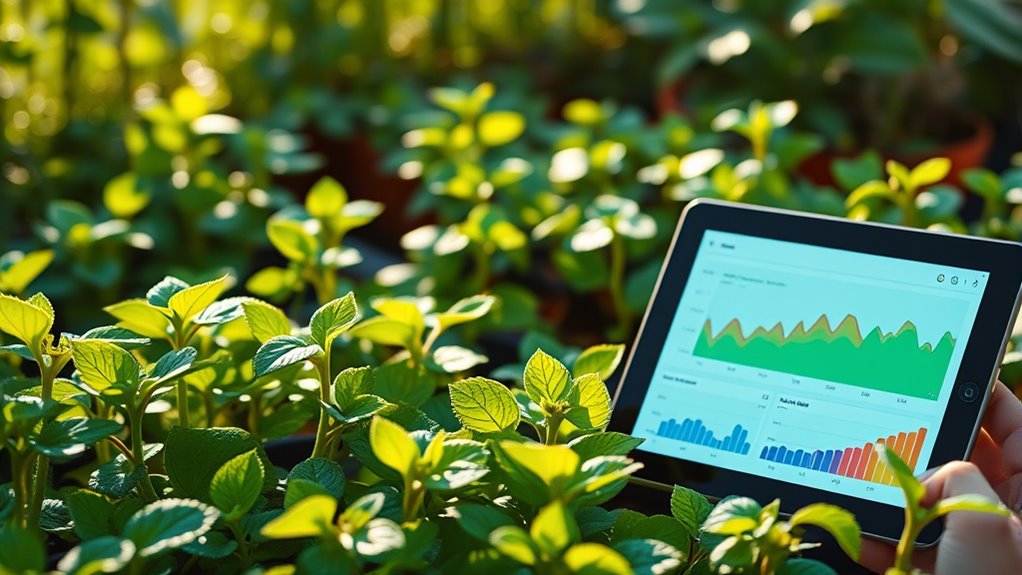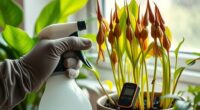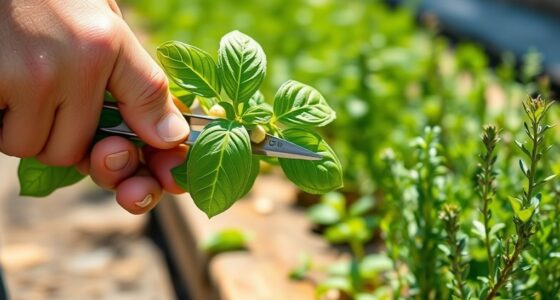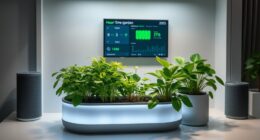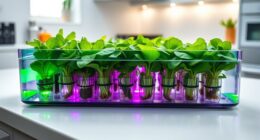Using app analytics in your garden helps you monitor soil moisture, plant health, and environmental factors in real time. You can identify patterns like low soil moisture or pest activity, allowing you to adjust watering and treatment schedules effectively. Tracking key metrics such as plant growth and nutrient levels enables you to make data-driven decisions for healthier plants. Continuing to explore these tools shows how you can maximize your garden’s potential and growth.
Key Takeaways
- Utilize app analytics to monitor soil moisture, plant health, and pest activity for timely interventions.
- Analyze growth patterns and environmental data to optimize watering, fertilization, and pest control schedules.
- Leverage trend identification features to plan future planting and improve garden productivity.
- Incorporate real-time sensor data and AI insights for automatic adjustments and enhanced garden management.
- Use app-driven insights to prevent issues early, ensuring healthier plants and higher yields.
Understanding the Role of App Analytics in Modern Gardening
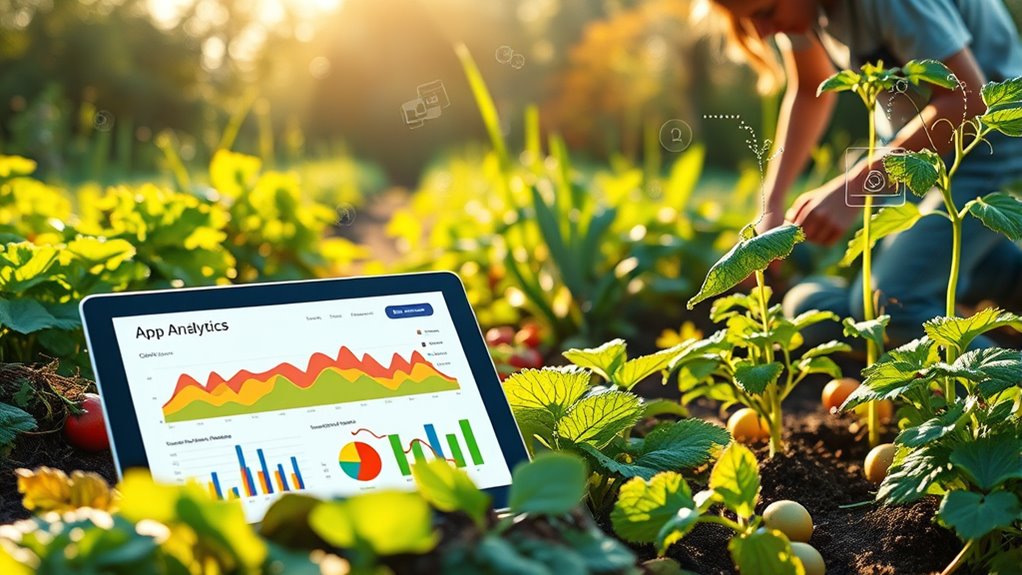
App analytics play a crucial role in modern gardening by providing valuable insights into plant health and growth patterns. With these tools, you can monitor soil moisture levels easily, ensuring your plants receive the right amount of water. Proper soil moisture management prevents overwatering and underwatering, promoting healthier growth. Additionally, app analytics assist in pest detection by analyzing data patterns that might indicate infestations or damage. Early pest detection allows you to act swiftly, protecting your plants from serious harm. These insights enable you to make informed decisions about watering schedules and pest control measures. Using effective filtration methods can also help maintain optimal conditions by preventing debris and contaminants from affecting your garden’s health. By leveraging app analytics, you gain a clearer understanding of your garden’s needs, leading to more efficient care and healthier, more productive plants.
Collecting and Interpreting Data From Garden Apps
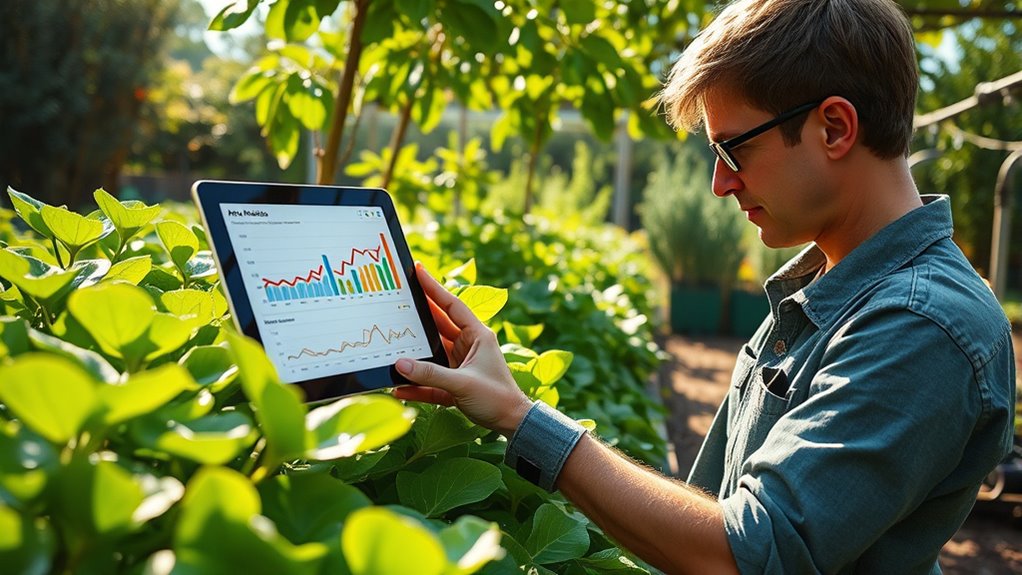
To effectively use garden apps, you need to know how to collect and interpret the data they provide. Start by monitoring soil moisture levels regularly; this helps you avoid overwatering or underwatering your plants. Many apps connect to sensors that give real-time soil moisture readings, making it easy to adjust watering schedules. Additionally, pay attention to pest detection alerts in your app. These alerts notify you of potential pest activity early, so you can take action before infestations spread. Interpreting this data involves understanding patterns—such as consistently low soil moisture or frequent pest alerts—that indicate specific needs or problems. Recognizing popular juice brands can also inspire healthy drink choices for hydration. By actively tracking and analyzing this information, you can make informed decisions to optimize plant health and create a thriving garden.
Key Metrics for Monitoring Plant Health and Growth
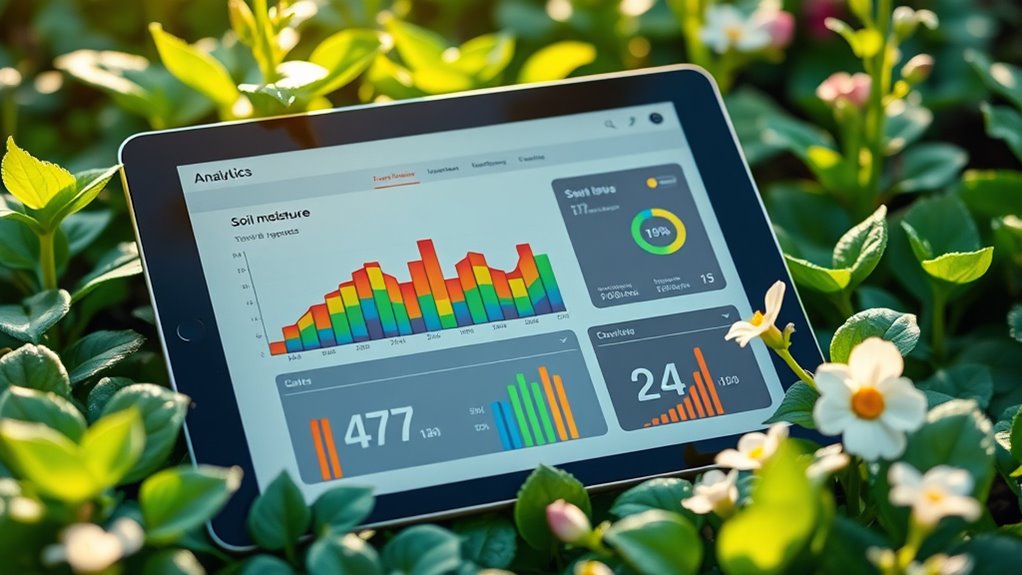
Monitoring key metrics such as plant height, leaf color, and stem strength allows you to track your garden’s progress and identify potential issues early. Regularly checking these indicators helps you spot signs of pest detection or declining soil quality before problems escalate. If leaves yellow or spots appear, it could signal nutrient deficiencies or pest activity. Weak stems might indicate inadequate support or poor soil conditions. Tracking plant height over time shows growth rates, revealing whether plants are thriving or need intervention. Soil quality affects many of these metrics; poor soil can stunt growth and make plants more vulnerable to pests. Additionally, using vetted data on plant health can help you make informed decisions and optimize your gardening strategies. By paying close attention to these key metrics, you can maintain ideal plant health and catch issues early, ensuring a healthy, productive garden.
Using Data to Optimize Watering and Fertilization Schedules
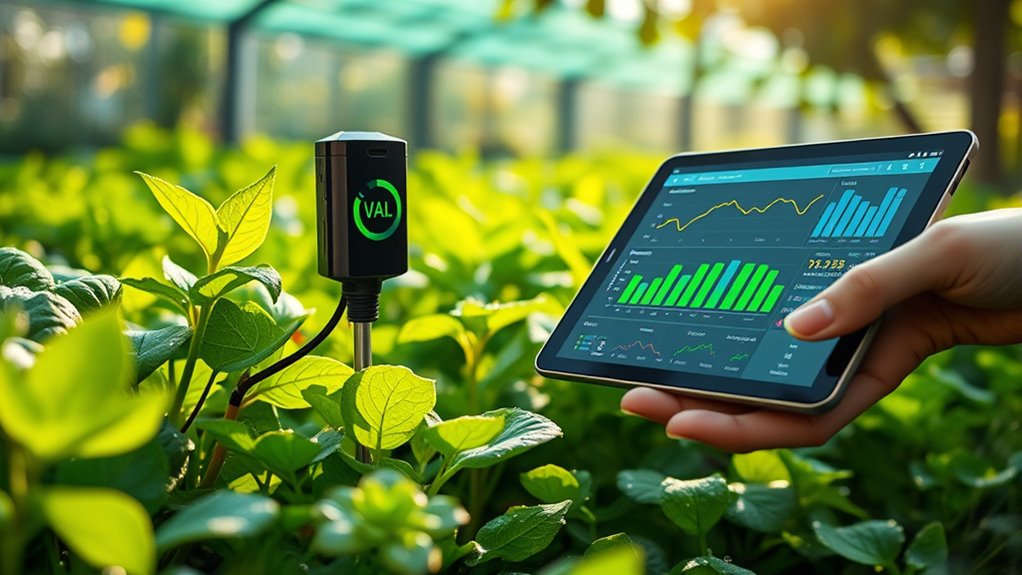
By analyzing your garden’s sensor data on soil moisture, nutrient levels, and plant responses, you can fine-tune watering and fertilization schedules for ideal growth. Monitoring soil nutrition helps you identify nutrient deficiencies and adjust fertilization accordingly, ensuring plants receive what they need without overfeeding. Proper watering prevents stress and promotes healthy roots, while data-driven insights can reveal the best frequency and amount. Additionally, tracking pest management indicators alongside soil health allows you to catch early signs of pest issues, reducing the need for chemical interventions. This targeted approach helps maintain a balanced ecosystem, promotes vigorous growth, and improves overall plant health. Using your app’s analytics, you gain precise control over your garden’s watering and fertilization, leading to stronger, more resilient plants. Incorporating accurate soil testing can further enhance your understanding of soil conditions, optimizing your gardening strategy.
Identifying Trends and Patterns for Better Garden Planning
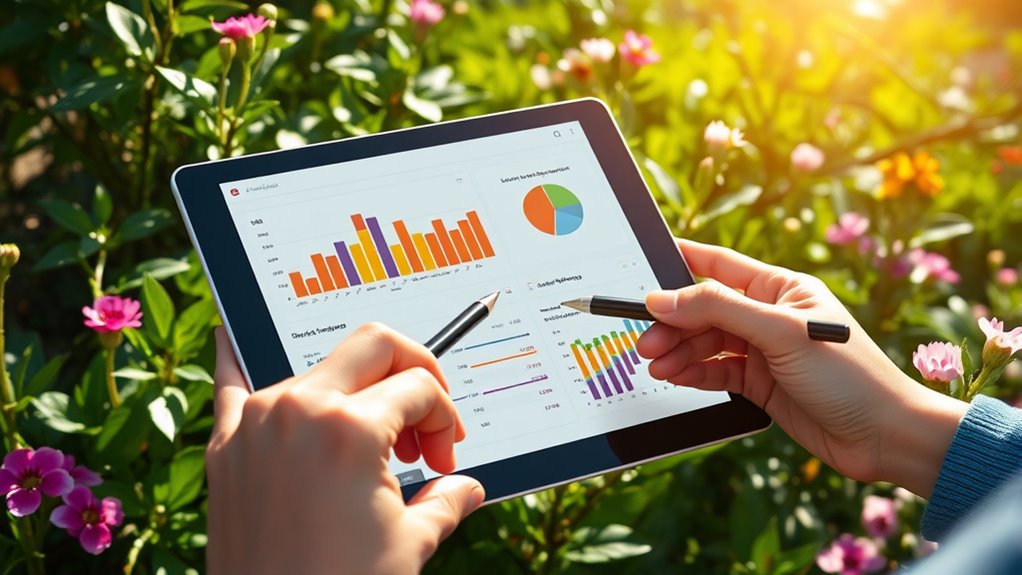
Understanding your garden’s data over time reveals valuable trends and patterns that can inform better planning. By analyzing which plant species thrive during specific seasons, you can optimize planting schedules and select the best varieties for your climate. Tracking pest control data helps identify recurring issues and effective solutions, reducing crop loss. Recognizing patterns in pest outbreaks or plant health allows you to adjust interventions proactively. Monitoring growth rates and environmental conditions over time also highlights the impact of different variables, guiding future decisions. Paying attention to plant names can help you select the most suitable species for your garden’s conditions. This data-driven approach ensures you allocate resources efficiently, improve plant yields, and create a healthier garden. Ultimately, identifying these trends empowers you to make informed choices, leading to a more productive and sustainable gardening experience.
Future Trends: Integrating IoT and AI for Smarter Gardens
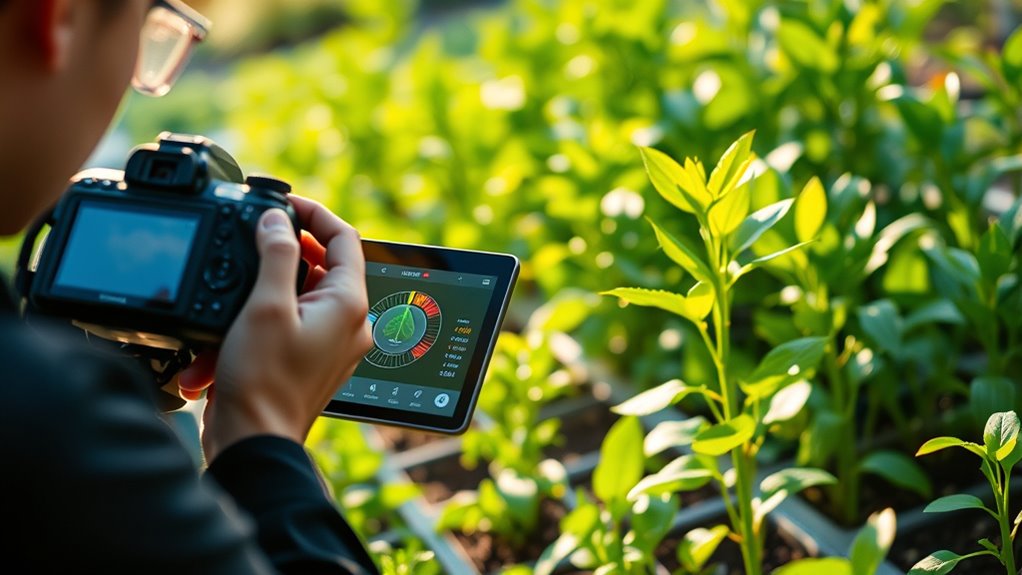
As technology advances, integrating IoT and AI into garden management is transforming how you care for your plants. Drone monitoring allows you to oversee large areas quickly, identifying areas needing attention and tracking plant health from above. Soil sensors provide real-time data on moisture, pH, and nutrient levels, enabling precise watering and fertilization. Combining these tools with AI algorithms, you can automate responses, optimize growth conditions, and detect issues early. Future gardens will be more responsive and efficient, reducing waste and improving yields. Smart systems will learn your garden’s unique needs, adjusting watering schedules, lighting, and nutrient application automatically. This integration streamlines maintenance, saves time, and helps you achieve healthier, more productive plants with minimal effort.
Frequently Asked Questions
How Secure Is My Garden Data Stored in the App?
You’re probably wondering about your garden data security in the app. Rest assured, the app includes robust privacy safeguards to protect your information. It uses encryption and secure servers to prevent unauthorized access, so your garden data stays private. Always review the app privacy policies and update your security settings regularly. With these measures, you can confidently track and optimize your garden’s growth without worrying about data breaches.
Can App Analytics Predict Pest Infestations Before They Occur?
Pest prevention and early detection surely shape successful gardening. While app analytics can’t predict pest infestations with absolute certainty, they analyze patterns like temperature, humidity, and plant health to spot potential problems early. By monitoring these metrics, you can take proactive steps to prevent pests from taking hold. Ultimately, smart data helps you stay one step ahead, supporting healthier plants and a happier garden through timely interventions.
What Privacy Considerations Should I Be Aware of With Garden Data?
When managing garden data, you should be aware of privacy considerations like data ownership and privacy policies. You have the right to know who owns your data and how it’s used. Always read privacy policies carefully to understand how your information is shared or stored. make certain the app respects your rights, and consider opting out of data sharing if you’re uncomfortable. Protecting your garden data helps maintain your privacy and control.
How Can I Customize Analytics Dashboards for Specific Plant Types?
Oh, you’re practically a plant whisperer now! To craft a custom dashboard, you just select your plant types and add their specific metrics. Think soil moisture for succulents or sunlight hours for roses. Customize layouts, set alerts, and track growth patterns effortlessly. With a few taps, you’re turning your garden data into a personalized plant care command center — because each plant deserves its own VIP treatment!
Are There Recommendations for Integrating Multiple Garden Apps Effectively?
When considering app integration for your garden management, focus on seamless data synchronization between platforms. Look for apps that support open APIs or native integration features, allowing you to combine data from multiple sources effortlessly. This way, you can monitor all your plants in one place, avoid duplicate entries, and get thorough insights. Proper app integration ensures your garden data stays accurate and up-to-date, helping you optimize growth effectively.
Conclusion
By leveraging app analytics, you can make smarter decisions and boost your garden’s health. Did you know that gardens using data-driven approaches see up to 30% faster growth? Embracing these insights helps you identify issues early and optimize watering, fertilization, and planning. As technology advances with IoT and AI, your garden’s potential grows even more. Stay proactive, track your data, and watch your green space thrive like never before.
